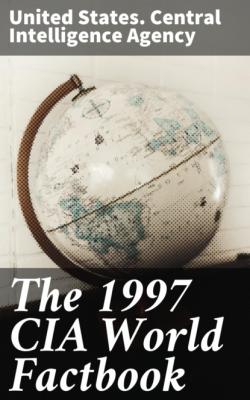The 1997 CIA World Factbook. United States. Central Intelligence Agency
Чтение книги онлайн.
Читать онлайн книгу The 1997 CIA World Factbook - United States. Central Intelligence Agency страница 22
 785–1258
785–1258
Diplomatic representation from the US: chief of mission: Ambassador Donald K. STEINBERG embassy: No. 32 Rua Houari Boumedienne, Miramar, Luanda mailing address: C.P. 6484, Luanda; American Embassy, Department of State, Washington, DC 20521–2550 (pouch) telephone : [244] (2) 345–481, 346–418 FAX: [244] (2) 346–924
Flag description: two equal horizontal bands of red (top) and black with a centered yellow emblem consisting of a five-pointed star within half a cogwheel crossed by a machete (in the style of a hammer and sickle)
Economy
Economy - overview: Angola is an economy in disarray. Despite its abundant natural resources, output per capita is among the world's lowest. Subsistence agriculture provides the main livelihood for 80%-90% of the population but accounts for about 12% of GDP. Oil production and the supporting activities are vital to the economy, contributing about 50% to GDP. Notwithstanding the signing of a peace accord in November 1994, sporadic violence continues, millions of land mines remain, and many farmers are reluctant to return to their fields. As a result, much of the country's food must still be imported. To take advantage of its rich resources - notably gold, diamonds, extensive forests, Atlantic fisheries, arable land, and large oil deposits - Angola will need to observe the cease-fire, implement the peace agreement, and reform government policies. Despite the high inflation and political difficulties, total output grew an estimated 9% in 1996, largely due to increased oil production.
GDP: purchasing power parity - $8.3 billion (1996 est.)
GDP - real growth rate: 9% (1996 est.)
GDP - per capita: purchasing power parity - $800 (1996 est.)
GDP - composition by sector: agriculture: 12% industry: 56% services: 32% (1994 est.)
Inflation rate - consumer price index: 1,700% (1996 est.)
Labor force: total: 2.783 million economically active by occupation: agriculture 85%, industry 15% (1985 est.)
Unemployment rate: extensive unemployment and underemployment affecting more than half the population (1994 est.)
Budget: revenues: $928 million expenditures: $2.5 billion, including capital expenditures of $963 million (1992 est.)
Industries: petroleum; diamonds, iron ore, phosphates, feldspar, bauxite, uranium, and gold; cement; basic metal products; fish processing; food processing; brewing; tobacco products; sugar; textiles;
Industrial production growth rate: NA%
Electricity - capacity: 620,000 kW (1994)
Electricity - production: 1.82 billion kWh (1994)
Electricity - consumption per capita: 171 kWh (1995 est.)
Agriculture - products: bananas, sugarcane, coffee, sisal, corn, cotton, manioc (tapioca), tobacco, vegetables, plantains; livestock; forest products; fish
Exports: total value: $4 billion (f.o.b., 1996 est.) commodities: crude oil 90%, diamonds, refined petroleum products, gas, coffee, sisal, fish and fish products, timber, cotton partners: US 70%, EU
Imports: total value : $1.7 billion (f.o.b., 1995 est.) commodities: capital equipment (machinery and electrical equipment), vehicles and spare parts; medicines, food, textiles and clothing; substantial military supplies partners : Portugal, Brazil, US, France, Spain
Debt - external: $12.5 billion (1996 est.)
Economic aid: recipient: ODA, $451 million (1994)
Currency: 1 new kwanza (NKz) = 100 lwei
Exchange rates: new kwanza (NKz) per US$1 - 201,994 (November 1996), 900,000 (25 April 1995), 600,000 (10 January 1995), 90,000 (1 June 1994), 7,000 (16 December 1993), 3.884 (July 1993), 550 (April 1992) note: black market rates - new Kwanza (NKz) per US$1 - 1,900,000 (6 April 1995), 180,000 (1 June 1994), 50,000 (16 December 1993)
Fiscal year: calendar year
@Angola:Communications
Telephones: 78,000 (1991 est.)
Telephone system: telephone service limited mostly to government and business use; HF radiotelephone used extensively for military links domestic: limited system of wire, microwave radio relay, and tropospheric scatter international: satellite earth stations - 2 Intelsat (Atlantic Ocean)
Radio broadcast stations: AM 17, FM 13, shortwave 0
Radios: NA
Television broadcast stations: 6
Televisions: 50,000 (1993 est.)
@Angola:Transportation
Railways: total : 2,952 km limited trackage in use because of land mines still in place from the civil war) (1997 est.) narrow gauge: 2,798 km 1.067-m gauge; 154 km 0.600-m gauge
Highways: total: 72,626 km paved: 18,157 km unpaved: 54,469 km (1995 est.)
Waterways: 1,295 km navigable
Pipelines: crude oil 179 km
Ports and harbors: Ambriz, Cabinda, Lobito, Luanda, Malogo, Namibe,
Porto Amboim, Soyo
Merchant marine: total : 11 ships (1,000 GRT or over) totaling 55,255 GRT/86,886 DWT ships by type: cargo 10, oil tanker 1 (1996 est.)
Airports: 144 (1996 est.)
Airports - with paved runways: total : 67 over 3,047 m: 3 2,438 to 3,047 m : 9 1,524 to 2,437 m: 11 914 to 1,523 m: 4 under 914 m: 40 (1996 est.)
Airports - with unpaved runways: total : 77 over 3,047 m: 1 2,438 to 3,047 m: 4 1,524 to 2,437 m: 24 914 to 1,523 m: 48 (1996 est.)
Military
Military branches: Army, Navy, Air and Air Defense Forces, National
Police Force
Military manpower - military age: 18 years of age
Military manpower - availability: males age 15–49: 2,412,445 (1997 est.)
Military manpower - fit for military service: males: 1,213,988 (1997 est.)
Military manpower - reaching military age annually: males : 102,712 (1997 est.)
Military expenditures - dollar figure: $1.1 billion (1993)
Military expenditures - percent of GDP: 31% (1993)
Transnational Issues
Disputes - international: none
Illicit drugs: increasingly used as a transshipment point for cocaine and heroin destined for Western Europe and other African states ______________________________________________________________________
ANGUILLA
(dependent